Note: This information is from 2022 but much has changed since then. Please be sure to discuss your unique financial situation with your McKinley Carter Advisor or another trusted professional.

Read Senior Investment Strategist Dave Nolan's first quarter review and market outlook for 2022.
Part 1: Looking back at Q1 2022
Part 2: What actions did we take in McKinley Carter portfolios in Q1?
Part 3: A look ahead - our outlook for the rest of 2022
Looking back at Q1 2022
With the dramatic changes that took place in the economy and geopolitically in the first quarter, we must ask ourselves if we are in the “eye” of the storm with more dramatic actions to come as the year progresses or are the markets adjusting to new realities and therefore volatility will be more muted as the year progresses? While the Russian attack on Ukraine was certainly an unforeseen development with limited visibility as to the full geopolitical and economic ramifications, the Federal Reserve’s move to remove the excess monetary stimulus added in 2020 and 2021 from the economy was well telegraphed.
In our year-end outlook, we forecasted a positive year for stocks in 2022 but cautioned that volatility would likely be higher this year and that bond performance would likely be challenged by a less accommodative Federal Reserve policy. While the stock market is down YTD, our forecast of greater volatility and poor bond performance was right on target.
At the lowest point during the first quarter, the S&P 500 and international stocks dropped by 12%, the Russell 2000 Index of small cap stocks dropped by 14%, and the NASDAQ 100 Index, which is dominated by technology stocks, dropped a whopping 20%. Worries over inflation, rising interest rates, and the Russian invasion of Ukraine caused investors to rush out of large, mid, and small cap stocks, but especially those stocks that were extremely expensive on a price-to-earnings (PE) basis. Some particularly speculative stocks lost over 75% of their market value!
The bond market also suffered in the quarter, falling nearly 7%, as interest rates rose because of inflation concerns and worries that the Federal Reserve would raise short term rates throughout the rest of the year.
Fortunately, a good portion of the damage experience in the stock market was reversed in late March as bargain hunters came into the market as it became evident that many companies were able to pass cost increases along to customers. While this is not good news for us as consumers, it is good news for us as investors.
In our last report, we highlighted three risks to our forecast that stock prices would rise in 2022, and that much of the current inflation surge would prove temporary:
RISK NUMBER 1: We said that COVID variants might continue to stall the global economic recovery.
While a number of Asian countries are still experiencing elevated COVID cases and periodic lockdowns, most of the world is seeing dramatic declines in Omicron cases and economies are opening back up. This is certainly a positive for global earnings.
RISK NUMBER 2: We said that high inflation might be more persistent than we expect.
Inflation is currently running at over 7%, well above the Federal Reserve’s 2% long-term target and at a 40-yr. high as reopening economies around the world are seeing sharp pent-up demand for goods and services. The Russian invasion of Ukraine, which first and foremost is a humanitarian tragedy, has turbocharged the inflation problem as about 40% of Europe’s natural gas supply and 25% of their oil supply comes from Russia. Russia is also a significant exporter of many of the world’s most needed commodities such as coal, nickel, uranium, aluminum, platinum, palladium, and iron ore. Additionally, Russia and Ukraine combine to provide more than 25% of global wheat production as well as being large producers of corn and vegetable oil. Disruptions to these critical supplies threaten global food markets and are leading to spiking prices as countries and consumers must pay more in the face of shortages.
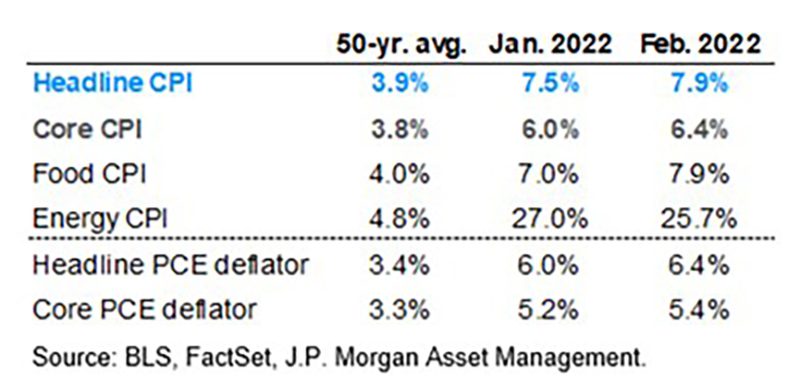
AND RISK NUMBER 3: We said that earnings growth could be more than offset by valuation contraction if interest rates rise more than expected.
S&P 500 earnings projections for 2022 are for a 7% increase. This figure could be in jeopardy should corporate input costs eat into profit margins and if the economy slows significantly due to aggressive interest rate increases by the Fed in an attempt to curb inflation. Persistently high inflation has historically led to a reduced valuation for the stock market as inflation-driven earnings increases are not viewed favorably by investors as they see their purchasing power diminished.
In sum, the first quarter of 2022 was the most volatile quarter for markets since the depths of the pandemic in 2020, as numerous risks to economic growth emerged. As we start the second quarter, investors will need to see incrementally positive progress across geopolitics, monetary policy expectations, and the outlook for inflation if the late-March rally is to continue.
First Quarter Performance Review
Stocks:
All four major equity indices posted negative returns for the first quarter of 2022, although the S&P 500 and the Dow Industrials saw only mild losses compared to the Nasdaq and Russell 2000. Investors rotated out of growth-oriented, high-P/E technology stocks and into sectors that were more exposed to the traditional economy which, generally speaking, trade at a cheaper valuation relative to the tech sector. That rotation benefitted the Dow Jones Industrial Average primarily while the Nasdaq Composite badly lagged both the S&P 500 and the Dow.
By market capitalization, large-cap stocks outperformed small-cap stocks in the first quarter, and that was to be expected given the geopolitical uncertainty and rising interest rates. Small-cap stocks typically are more reliant on debt financing to sustain their businesses, and therefore, rising interest rates can be a headwind on small-cap stocks. Additionally, investors flocked to the relative safety of large caps amid the rise in volatility over the course of the quarter.
From an investment style standpoint, value massively outperformed growth in the first quarter as select value ETFs registered positive returns over the past three months. Elevated volatility, geopolitical uncertainty, and the prospect of quickly rising interest rates caused investors to flee richly valued, growth-oriented tech stocks and rotate to less expensive sectors of the market.
On a sector level, only two of the eleven sectors in the S&P 500 finished the first quarter with a positive return. Energy was the clear standout as the sector benefitted from the increase in geopolitical uncertainty and subsequent surge in oil and natural gas prices in response to the Russia-Ukraine war. Utilities, a traditionally defensive sector, logged a modestly positive return as investors rotated to defensive sectors in response to elevated market volatility and geopolitical uncertainty. Finally, financials outperformed the S&P 500 and saw only a small loss as the sector has historically benefited from rising interest rates, although concerns about exposure to the Russian economy weighed on many financial stocks in February and early March.
Sector laggards included the communication services, tech, and consumer discretionary sectors as they saw material declines in the first quarter thanks primarily to the broad rotation away from the more highly valued corners of the market. Specifically, internet stocks weighed on the communications sector, while online retail stocks were a drag on the consumer discretionary sector. Away from tech and tech-related sectors, most other sectors in the S&P 500 saw modest declines that did not stray too far from the performance of the S&P 500.
Internationally, foreign markets declined in the first quarter. Geopolitical uncertainty hit foreign markets early in the quarter, erasing what was moderately positive performance until that point. Emerging markets slightly lagged foreign developed markets due to a stronger U.S. dollar and rising geopolitical risks, but the underperformance was modest.
Commodities:
Commodities registered massively positive returns in the first quarter primarily thanks to rising geopolitical risks. Oil, wheat, natural gas, corn, and other essential commodities surged on a combination of actual production outages related to the Russia-Ukraine war (which reduced current supply) and buyers locking in supply for fear of any future production disruptions should the war continue for months or spread beyond Ukraine’s borders.
Bonds:
Bonds registered some of the worst performance in years during the first quarter with most major bond indices declining as investors exited fixed income holdings in the face of high inflation and as the Federal Reserve consistently signaled that it was going to raise interest rates faster than investors had previously expected.
Looking deeper into the bond markets, shorter-term Treasury Bills outperformed longer-duration Treasury Notes and Bonds as high inflation and the threat of numerous future Fed rate hikes weighed on fixed income products with longer durations.
In the corporate debt markets, investment-grade bonds saw materially negative returns and underperformed lower-quality but higher-yielding corporate debt, which also declined but more modestly so. This underperformance in investment-grade debt reflected the impact of rising Treasury yields, while the outperformance of high-yield corporate bonds served as a reminder of the still-positive outlook for the U.S. economy and corporate America.
| U.S. Equity Indexes | Q1 Return |
|---|---|
| S&P 500 | -4.60% |
| DJ Industrial Average | -4.10% |
| NASDAQ 100 | -8.91% |
| S&P MidCap 400 | -4.88% |
| Russell 2000 | -7.53% |
Source: YCharts
| International Equity Indexes | Q1 Return |
|---|---|
| MSCI EAFE TR USD (Foreign Developed) | -5.79% |
| MSCI EM TR USD (Emerging Markets) | -6.92% |
| MSCI ACWI Ex USA TR USD (Foreign Dev & EM) | -5.33% |
Source: YCharts
| Commodity Indexes | Q1 Return |
|---|---|
| S&P GSCI (Broad-Based Commodities) | 33.13% |
| WTI Crude Oil | 34.42% |
| Gold Price | 6.61% |
Source: YCharts/Koyfin.com
| U.S. Bond Indexes | Q1 Return |
|---|---|
| BBgBarc US Agg Bond | -5.93% |
| BBgBarc US T-Bill 1-3 Mon | 0.03% |
| ICE US T-Bond 7-10 Year | -6.54% |
| BBgBarc US MBS (Mortgage-backed) | -4.97% |
| BBgBarc Municipal | -6.23% |
| BBgBarc US Corporate Invest Grade | -7.69% |
| BBgBarc US Corporate High Yield | -4.84% |
Source: YCharts
What actions did we take in McKinley Carter portfolios in Q1?
January
In the Dividend Focus (DF) program, we sold AAPL, T, VZ, KO, INTC, MCD, O, SO, and TGT and bought AMT, AVGO, CLX, CMCSA, ORCL, UNP, UPS, UNH, and GWW as part of our new investment screening process for DF to better focus on the dividend growth rates of portfolio companies.
March
In our ActiveTrack (AT), Earnings Focus (EF), and Hybrid programs, we replaced the JP Morgan Emerging Markets Equity Fund (JEMSX) with the BlackRock Emerging Markets Fund (MADCX) to move the Emerging Markets allocation more towards a core allocation and less focused on a “growth stock” bias.
In our AT, EF, and Hybrid programs, we replaced the iShares MSCI USA Momentum Factor ETF (MTUM), which scored poorly in our scoring system, with the Pacer US Cash Cows 100 ETF (COWZ) in our Tactical allocation sleeve. COWZ screens for the highest 100 free cash flow yields among the Russell 1000 members and selects those companies with both high cash flow and inexpensive valuations. Healthcare and Energy stocks represent the largest two sectors in the fund.
In AT, we reduced our Tactical allocation sleeve from 16.3% to 10% of equities. We moved that 6.3% excess allocation to U.S. equities by adding the iShares Russell Top 200 ETF (IWL) and reducing exposure to the iShares Russell 2000 Value ETF (IWN). This allocation to IWL allows us to better conform to the Strategy Committee’s preference for larger cap companies in a challenging market environment with a Fed tightening designed to mitigate inflation by slowing the economy.
A look ahead - our outlook for the rest of 2022
As we start a new quarter, markets are facing the most uncertainty since the pandemic, as headwinds from inflation, less-accommodative monetary policy, and geopolitics remain in place. Despite the positive news about falling COVID cases and reduced hospitalizations, the inflation and interest rate concerns look to be with us for a while and the lasting impact from the Russia-Ukraine war on global economies is an unknown.
Inflation sits near a 40-year high and with major commodities such as oil, wheat, corn, and natural gas surging in response to the Russia-Ukraine war, it’s unlikely that key inflation indicators like the Consumer Price Index will meaningfully decline anytime soon. Until there is a definitive peak in inflation, the Federal Reserve is likely to continue to aggressively raise interest rates, and over time, higher rates will become a drag on economic growth. Fortunately, rising food and energy prices don’t have the same impact on consumers that they did in prior periods of spiking inflation.
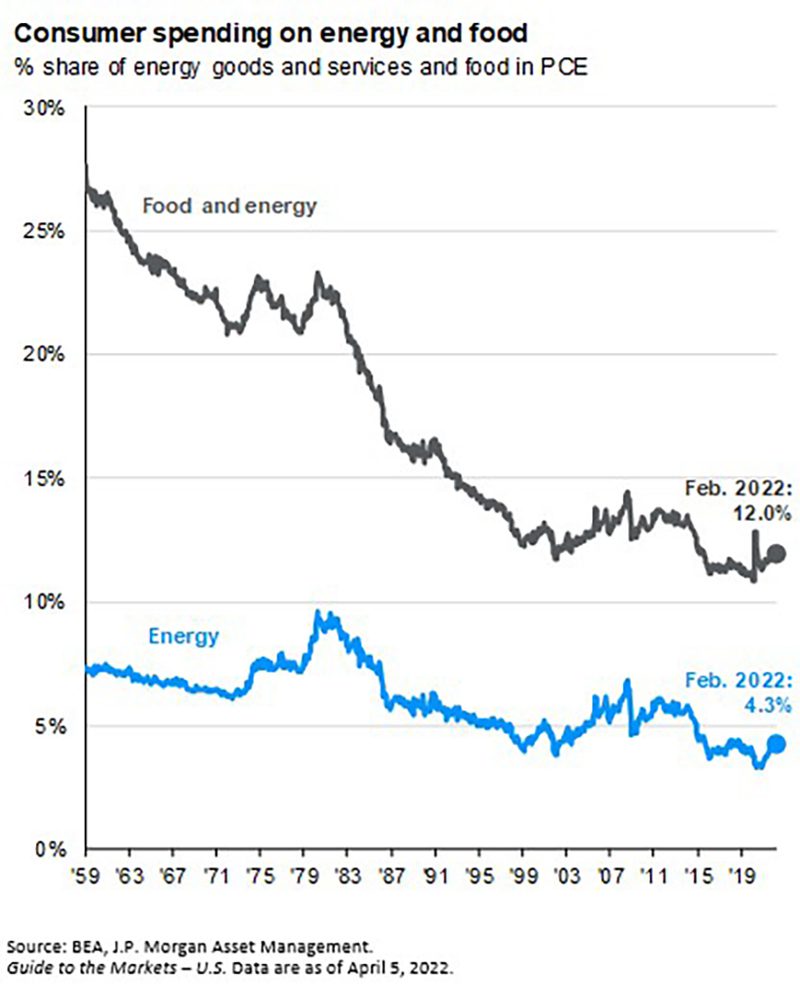
Recession indicator?
While much has been made of the recent “inversion” of Treasury bond yields where 2-yr. rates rise above longer-term rates, a phenomenon usually preceding recessions, the Federal Reserve focuses on the relationship between the three-month Treasury Bill yield and the 10-yr. Treasury Bond yield as a better indicator of near-term recession risks. This indicator currently reflects a very small (5.49%) probability of a recession.
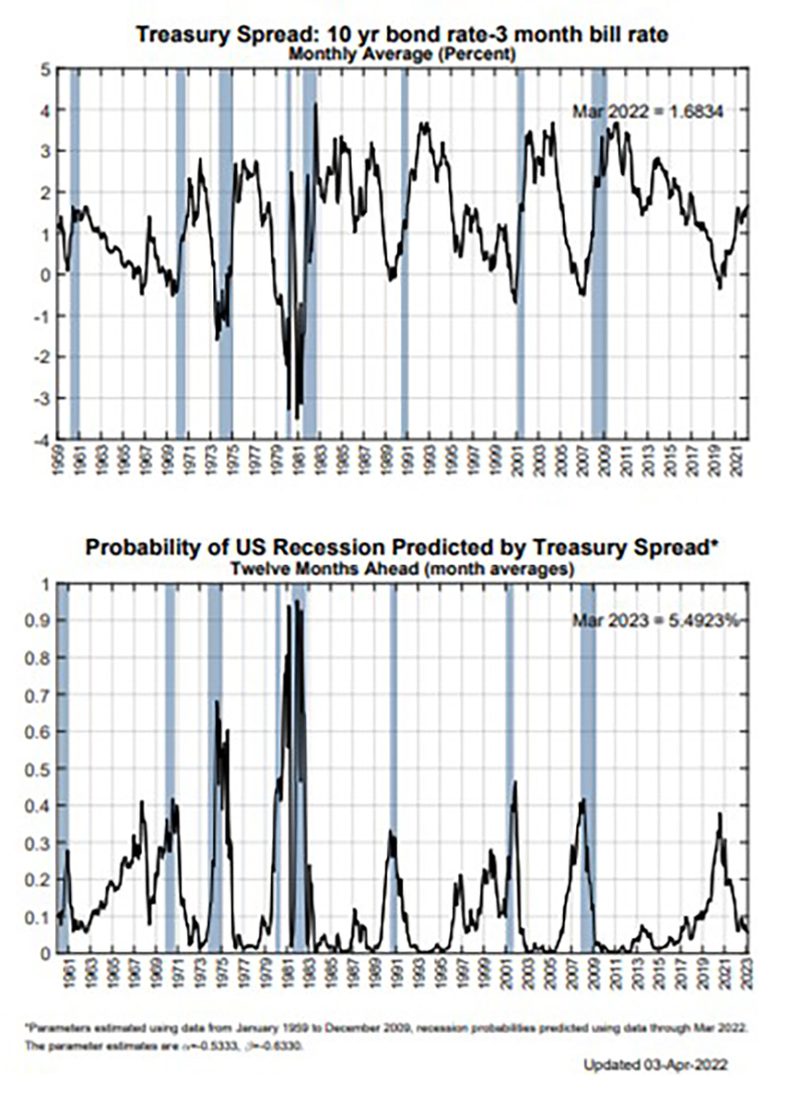
The Federal Reserve has warned markets that aggressive interest rate hikes are coming in the months ahead, and this quarter the Fed will reveal its balance sheet reduction plan, which will detail how the Fed plans to sell the assets it acquired via the Quantitative Easing program over the past two years. If the details of this balance sheet reduction plan are more aggressive than markets expect, or the Fed commits to more rate hikes than are currently forecasted by markets, that could weigh on stocks and bonds alike.
Even with this negative backdrop, as global economies recover from COVID concerns, we still expect 2022 to be another positive year for stocks, though returns will likely be modest. Excluding the ten largest companies in the S&P 500 Index, U.S. stocks are only slightly more expensive than their 25-yr. average valuations and they remain reasonably valued (16.6X next twelve months’ earnings estimates) relative to still historically expensive bonds. International stocks, while challenged by the impact of the Russia-Ukraine war, trade in line with their historical average valuations and are trading at steep discounts to U.S. stocks.
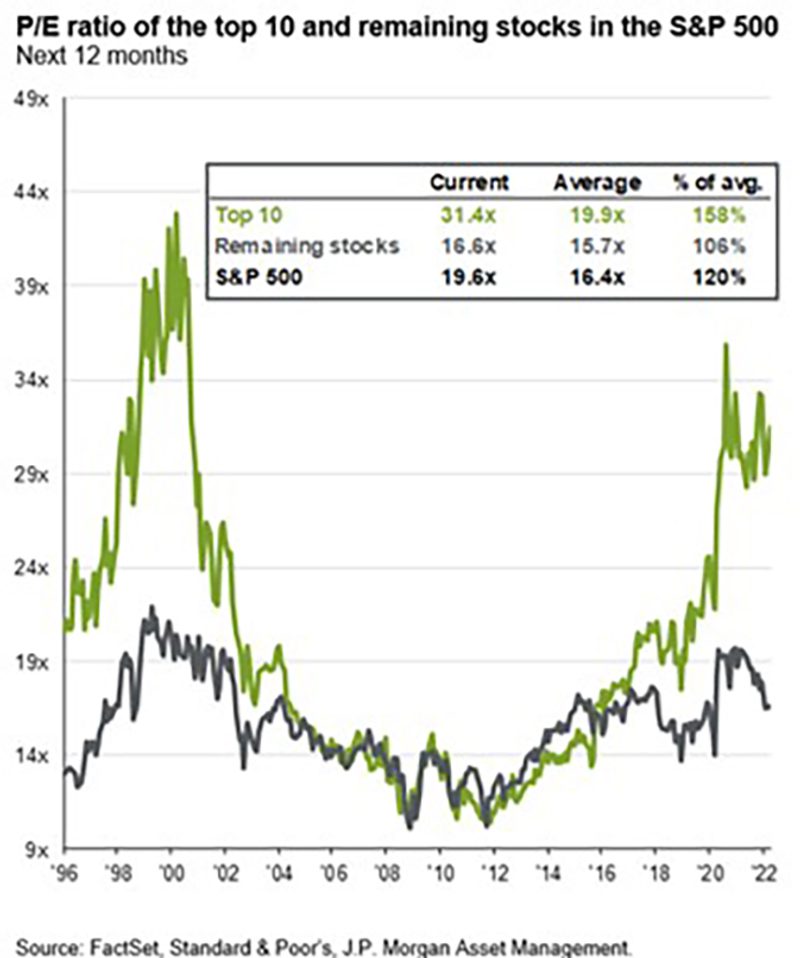
In addition, despite higher input costs due to inflation, corporate earnings and profit margins have held steady, and companies are flush with cash that can be used for stock buybacks and dividend increases. While we are attentive to any downward revisions in earnings estimates due to a slowing economy, thus far, overall revisions have been positive.
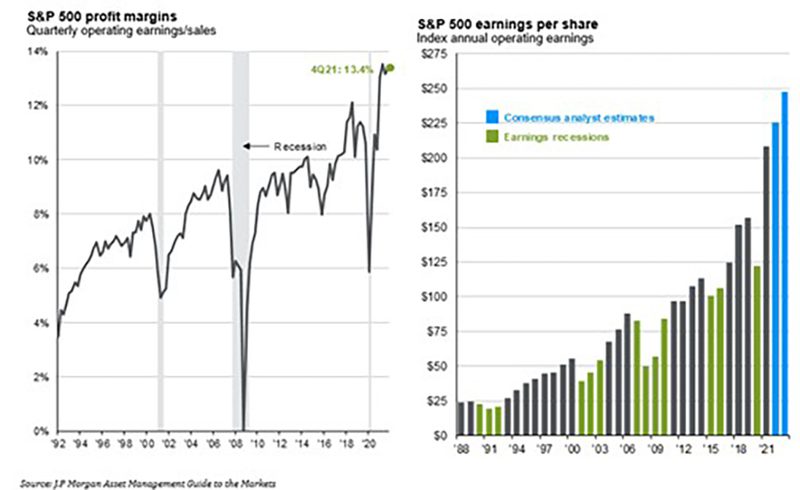
U.S. consumers are also in a favorable position with virtually full employment and relatively low debt compared to their now rising income levels (average hourly earnings rose 5.6% year-over-year in March).
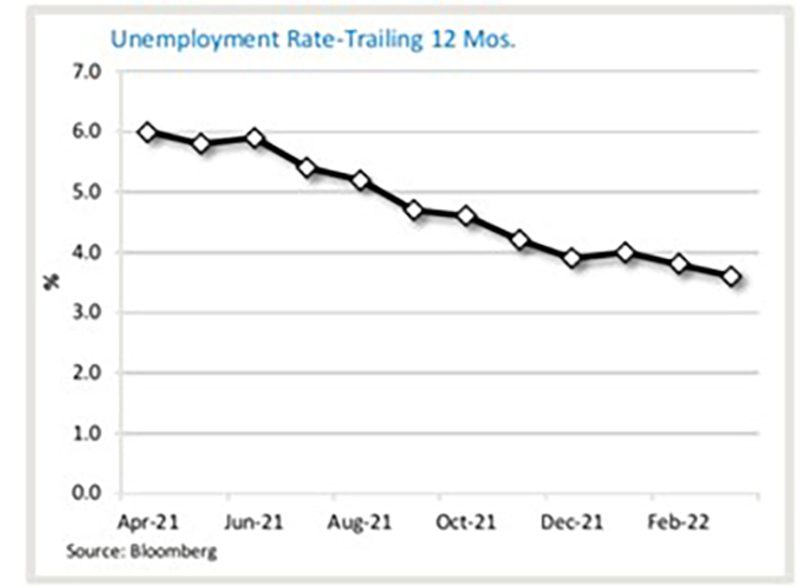
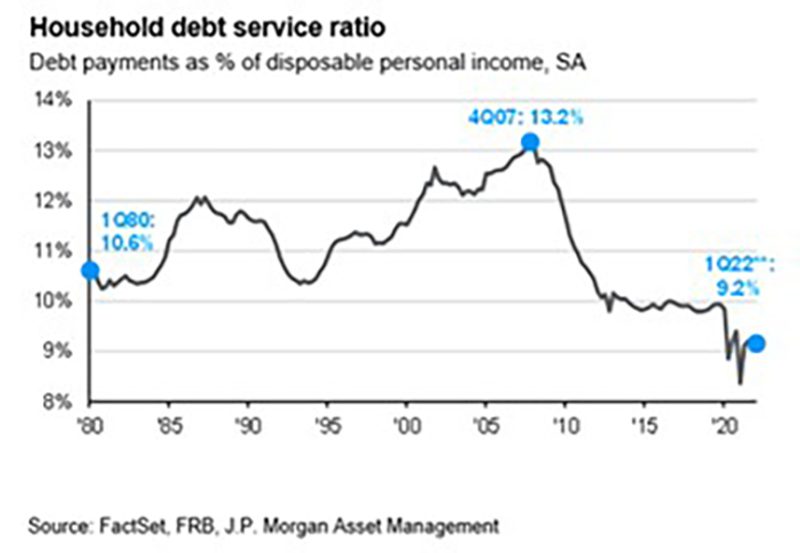
Bonds should experience their second consecutive down year as the Federal Reserve raises interest rates to slow the economy and allay inflation concerns. We believe Inflation is likely to peak sometime in 2022 as supply chain shocks ease and Federal Reserve (FOMC) actions slow economic demand for goods.
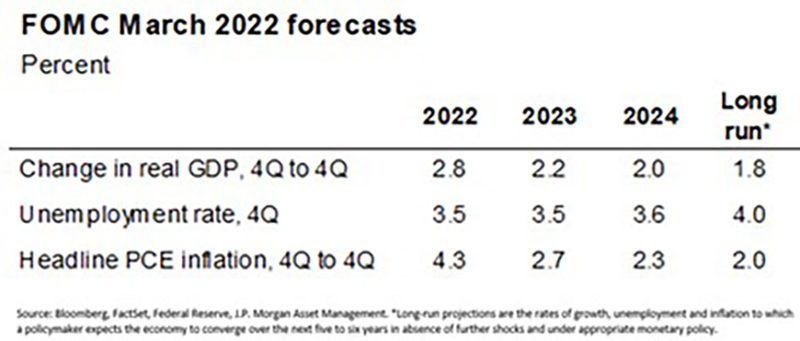
Final thoughts
Despite an onslaught of negative news this year – war in Ukraine, roaring inflation, Fed tightening announcements, rising interest rates, commodity shortages, trade sanctions, and COVID, the resilience of the stock market has been impressive and is another indication of the inherent strength of the U.S. economy and the ability of markets to look beyond current events. As consumers react to the lessening of COVID cases by spending more on services rather than goods, we feel the pressure on supply chains will abate and combined with Fed actions to slow the economy, inflation will peak in the second half of 2022. While interest rates will likely move higher from this point, the level of rates is not significantly constraining on the economy as we have dealt with much higher rates in past cycles. Additionally, while recession is always a possibility if economic conditions deteriorate, we don’t believe it is the most likely scenario. Acknowledging that the outcome of the Russia-Ukraine war is an unknown, it seems unlikely that Russia will expand the conflict by directly challenging a unified NATO, and history shows us that markets ultimately adjust to the new reality of military conflict.
We encourage investors to reflect on the history of stock market drops and the resulting appreciation from those lower levels. The chart below illustrates how this year’s stock market pullback of 13% (red dots show pullbacks from yearly highs) is certainly in line with the typical average annual correction of about 14%.

